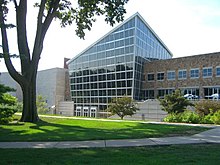Indiana State Museum

Front facade of the Indiana State Museum
|
|
| Established | 1869 |
|---|---|
| Location | 650 W. Washington St. Indianapolis, Indiana, United States |
| Coordinates | 39°46′7″N 86°10′9″W / 39.76861°N 86.16917°WCoordinates: 39°46′7″N 86°10′9″W / 39.76861°N 86.16917°W |
| Collection size | 542,000 |
| President | Thomas King |
| Owner | State of Indiana |
| Public transit access |
|
| Website | Official website |
The Indiana State Museum is a museum located within White River State Park in Indianapolis, Indiana, United States. The museum houses exhibits on the science, art, culture, and history of Indiana from prehistoric times up to the present day. The museum is also the site of the state's largest IMAX screen.
The original collection of the Indiana State Museum was started in 1862, during the Civil War, when State Librarian R. Deloss Brown began collecting minerals and other curiosities that he kept in a cabinet. In 1869, the Indiana General Assembly enacted a law which provided “for the collection and preservation of a Geological and Mineralogical Cabinet of the Natural History of this State.” A state geologist was assigned the task of labeling and organizing the collection, becoming the first employee of what would eventually become the Indiana State Museum.
The natural history collection quickly developed beyond the legislature’s original intent when hundreds of cultural items, many relating to the recent Civil War, were added. Soon the collection was a museum of sorts, with a hodge-podge of curios and specimens.
The museum’s collection was displayed in a spacious room on the third floor of the State Capitol building in 1888, but it did not remain there for long. It was frequently moved from room to room until 1919, when the collection was sent to a most inhospitable place, the basement of the Statehouse. It would languish in this location for almost 45 years, completely closing once in the late 1920s and again in the early 1960s.
During the administration of Governor Ralph F. Gates (1945-1949), steps were taken to establish a new and modern state museum. Staff members who knew how to care for artifacts and operate a museum were hired. Possible sites for a new facility were studied and designs created. "Philanthropist Eli Lilly, excited by the prospect of a professional-quality museum of Indiana heritage, donated the ground on the northwest corner of Ohio and Senate streets to the state. Unfortunately, the plans fell through, probably due to the $3.5 million price tag"(http://www.indianamuseum.org/about).
...
Wikipedia

